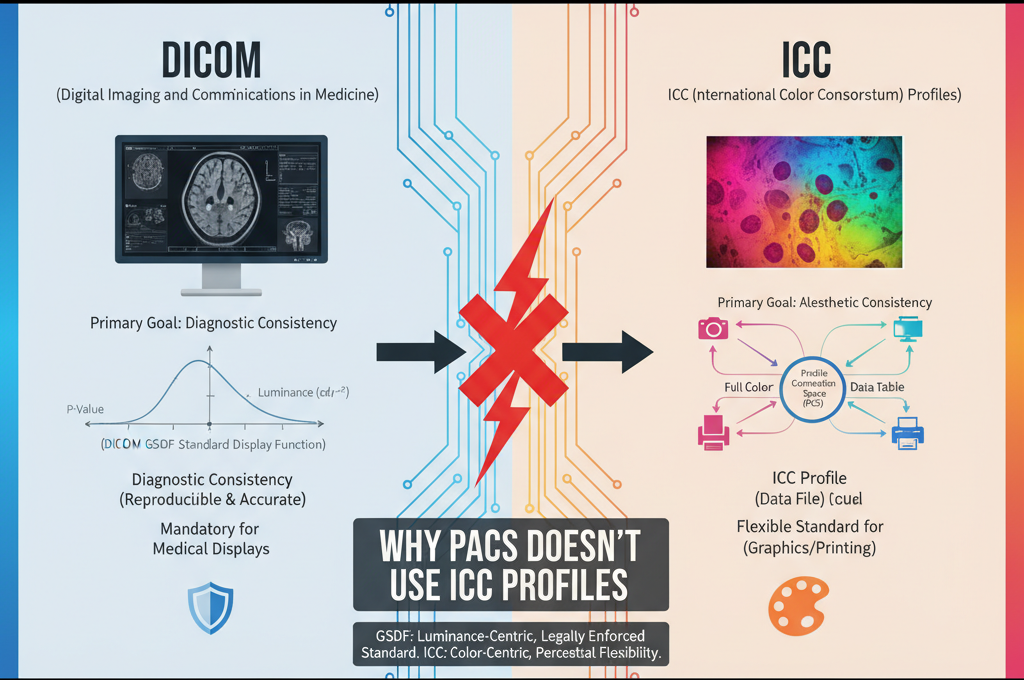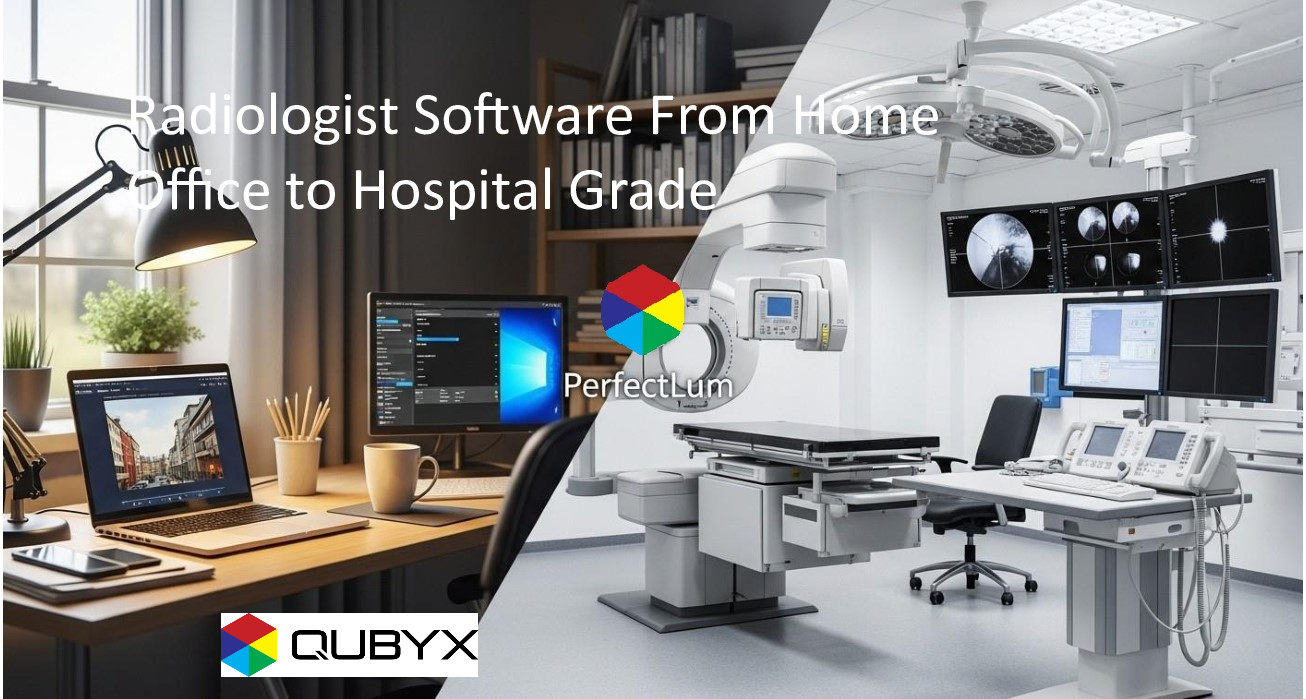News
- Home
- Why PACS Doesn’t Use ICC Profiles | DICOM vs ICC Explained

Why PACS Doesn’t Use ICC Profiles | DICOM vs ICC Explained
- October 10, 2025
- Shamsul
Why PACS Doesn’t Use ICC Profiles | DICOM vs ICC Explained
Introduction: When Precision Is Grayscale, Not Color
Medical imaging systems, particularly PACS (Picture Archiving and Communication Systems), are engineered for one thing above all else — diagnostic accuracy.
While most digital imaging workflows (like photography or printing) rely on ICC profiles to manage color consistency, PACS takes a different route entirely.
Instead of ICC’s color-centric methodology, PACS adheres to a more fundamental medical imaging standard — DICOM Part 14, also known as the Grayscale Standard Display Function (GSDF).
This is not a mere technical preference — it’s a clinical necessity that ensures that every shade of gray on an X-ray or CT scan looks perceptually identical across different displays.
1- DICOM Part 14: The Established King of Grayscale, Not Color
Grayscale Over Color
The majority of radiological imaging — including X-rays, CT, MRI, and mammography — is inherently grayscale, not RGB.
That means the priority is not on hue or saturation accuracy but on the perceptual linearity of luminance.
The DICOM Part 14 GSDF standard (introduced in 1998) defines how brightness values (luminance) should be displayed so that equal steps in pixel value correspond to equal steps in human visual perception.
This ensures that a radiologist viewing a scan in Tokyo perceives the same contrast transitions as a colleague in Berlin — regardless of hardware.
In contrast, ICC profiles are optimized for color devices (printers, monitors, cameras) that operate in RGB or CMYK color spaces. They ensure consistent color appearance across devices, but they lack medical perceptual mapping for grayscale linearity.
In short: ICC = artistic accuracy; DICOM GSDF = diagnostic reliability.
2- Why ICC Profiling Isn’t Used in PACS Environments
Different Calibration Goals
-
ICC Profiling Goal: Achieve consistent color across devices using colorimetric mapping (CIE XYZ, Lab, etc.).
-
DICOM GSDF Goal: Maintain perceptually uniform grayscale luminance for accurate tissue contrast interpretation.
Technical Incompatibilities
-
ICC profiles describe transformations between device color spaces, assuming a visual model of color perception (chromatic adaptation).
-
DICOM GSDF, on the other hand, defines a nonlinear luminance function specific to medical images — not just brightness correction but contrast perception modeling based on the Barten curve (human visual response).
Regulatory & Clinical Requirements
Medical imaging standards, such as AAPM TG18, DIN 6868-157, and IEC 62563-1, explicitly reference DICOM GSDF as the calibration basis for diagnostic monitors.
No such standard accepts ICC profiling as sufficient for clinical interpretation.
Therefore, PACS systems ignore ICC profiles because:
-
They do not align with DICOM’s perceptual model.
-
They lack luminance compliance tracking.
-
They cannot guarantee consistent grayscale contrast thresholds critical for diagnosis.
3- DICOM GSDF: The Precision Backbone of PACS
How GSDF Works
The GSDF defines 1023 Just Noticeable Differences (JNDs) — perceptual brightness steps measurable by human vision.
Each step ensures the eye perceives a consistent change in contrast — a requirement for detecting subtle lesions, microcalcifications, or vascular anomalies.
This mapping is encoded directly into DICOM’s calibration structure.
When PACS software displays an image:
-
It reads DICOM image pixel values.
-
It references the display’s calibrated luminance response function.
-
It applies corrections to render the image according to GSDF.
No ICC transformation is involved because color space mapping would distort grayscale accuracy.
4- The Role of Calibration Software like QUBYX PerfectLum
Although PACS software itself doesn’t use ICC profiles, calibration and QA tools such as QUBYX PerfectLum and QUBYX OS Tools bridge the technical gap between color science and clinical compliance.
PerfectLum’s Role
-
Implements DICOM Part 14 GSDF calibration automatically.
-
Supports verification protocols like AAPM TG18/TG270 and DIN 6868-157.
-
Ensures every grayscale step matches human visual sensitivity — across all connected PACS workstations.
-
Offers optional ICC profile generation for environments where color is relevant (e.g., surgical imaging, pathology, dermatology).
Thus, QUBYX unifies open-source color science and regulated medical imaging QA, making both grayscale and color workflows reliable — without compromising diagnostic accuracy.
5- Hybrid Future: Color in Medical Imaging
While grayscale still dominates radiology, emerging modalities such as digital pathology, endoscopy, and 3D surgical visualization require color consistency.
In these domains, ICC profiling complements, but never replaces, DICOM GSDF.
Future PACS and QA solutions may integrate dual-mode calibration, enabling both:
-
DICOM GSDF for grayscale studies, and
-
ICC-based color calibration for color imaging disciplines.
QUBYX OS Tools is already pioneering this hybrid approach — merging ICC 3D LUT generation with DICOM GSDF compliance in a single software stack.
Conclusion: Different Standards, Same Mission — Visual Trust
PACS software doesn’t use ICC profiling because its mission is not color fidelity — it’s diagnostic certainty.
DICOM Part 14’s GSDF ensures that radiologists can trust what they see, no matter the workstation or display.
Where ICC manages artistic truth, DICOM ensures clinical truth.
And thanks to innovators like QUBYX LLC, both worlds — color and grayscale — are converging through intelligent, open-source calibration technology.
Key Takeaways
✅ PACS relies on DICOM Part 14 GSDF, not ICC.
✅ GSDF ensures perceptual grayscale uniformity vital for diagnosis.
✅ ICC profiles are color-centric and unsuitable for luminance-critical imaging.
✅ Tools like QUBYX PerfectLum automate DICOM calibration and QA compliance.
✅ Future imaging systems may blend ICC color and DICOM grayscale workflows.
Call to Action
Learn more about QUBYX OS Tools and PerfectLum Suite — the most advanced software-first calibration solutions for radiology, teleradiology, and clinical imaging environments.
Visit www.qubyx.com
To secure medical-grade display precision while reducing the recurring costs of proprietary hardware, the answer is clear: transition to a software calibration platform like QUBYX OS Tools (Free) and PerfectLum today.
Tags:
PACS software, ICC profiling, DICOM Part 14, GSDF standard, medical imaging calibration, luminance curve, radiology display calibration, QUBYX PerfectLum, DICOM grayscale, DICOM vs ICC,
Related Posts
- October 15, 2025
- News
Enhancing Clinical Research Efficiency with Perfectlum Accelerating Clinical Research:
- October 15, 2025
- News
How PerfectLum Ensures Data Integrity and Secure Teleradiology Introduction:
- October 14, 2025
- News
Radiologist Software From Home Office to Hospital Grade Introduction:




